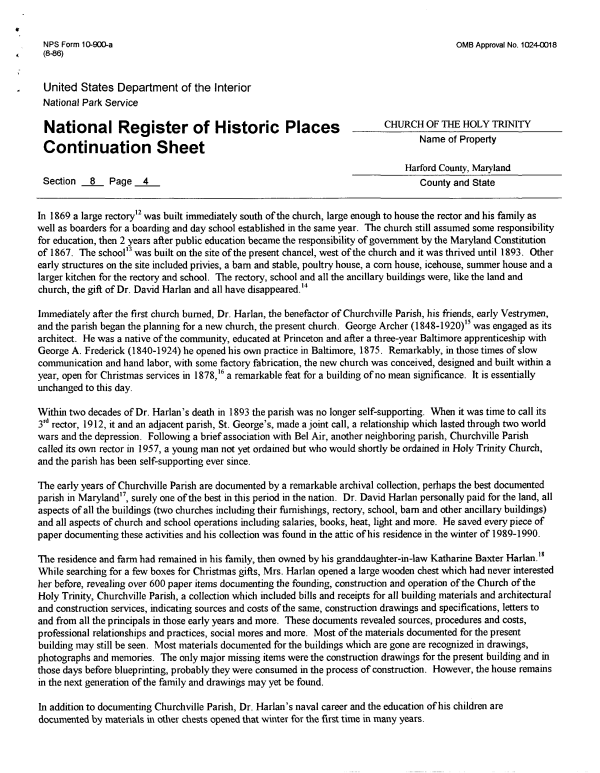 |
||||
|
DEPARTMENT OF HOUSING AND COMMUNITY DEVELOPMENT, MARYLAND HISTORICAL TRUST (Historic Sites Survey) var.d. MSA SE16-8 Image No: se16-8-0358 Enlarge and print image (94K) |
 |
||||
|
DEPARTMENT OF HOUSING AND COMMUNITY DEVELOPMENT, MARYLAND HISTORICAL TRUST (Historic Sites Survey) var.d. MSA SE16-8 Image No: se16-8-0358 Enlarge and print image (94K) |
| NPS Form 10-900-a OMB Approval No. 1024-0018 (8-86) United States Department of the Interior National Park Service National Register Of Historic Places CHURCH OF TOE HOLY TRINITY —k ,. «. ~. , Name of Property Continuation Sheet Harford County, Maryland Section 8 Page 4 County and State In 1869 a large rectory12 was built immediately south of the church, large enough to house the rector and his family as well as boarders for a boarding and day school established in the same year. The church still assumed some responsibility for education, then 2 years after public education became the responsibility of government by the Maryland Constitution of 1867. The school13 was built on the site of the present chancel, west of the church and it was thrived until 1893. Other early structures on the site included privies, a bam and stable, poultry house, a com house, icehouse, summer house and a larger kitchen for the rectory and school. The rectory, school and all the ancillary buildings were, like the land and church, the gift of Dr. David Harlan and all have disappeared.14 Immediately after the first church burned, Dr. Harlan, the benefactor of Churchville Parish, his friends, early Vestrymen, and the parish began the planning for a new church, the present church. George Archer (1848-1920)15 was engaged as its architect. He was a native of the community, educated at Princeton and after a three-year Baltimore apprenticeship with George A. Frederick (1840-1924) he opened his own practice in Baltimore, 1875. Remarkably, in those times of slow communication and hand labor, with some factory fabrication, the new church was conceived, designed and built within a year, open for Christmas services in 1878,16 a remarkable feat for a building of no mean significance. It is essentially unchanged to this day. Within two decades of Dr. Harlan's death in 1893 the parish was no longer self-supporting. When it was time to call its 3rd rector, 1912, it and an adjacent parish, St. George's, made a joint call, a relationship which lasted through two world wars and the depression. Following a brief association with Bel Air, another neighboring parish, Churchville Parish called its own rector in 1957, a young man not yet ordained but who would shortly be ordained in Holy Trinity Church, and the parish has been self-supporting ever since. The early years of Churchville Parish are documented by a remarkable archival collection, perhaps the best documented parish in Maryland17, surely one of the best in this period in the nation. Dr. David Harlan personally paid for the land, all aspects of all the buildings (two churches including their furnishings, rectory, school, barn and other ancillary buildings) and all aspects of church and school operations including salaries, books, heat, light and more. He saved every piece of paper documenting these activities and his collection was found in the attic of his residence in the winter of 1989-1990. The residence and farm had remained in his family, then owned by his granddaughter-in-law Katharine Baxter Harlan. While searching for a few boxes for Christmas gifts, Mrs. Harlan opened a large wooden chest which had never interested her before, revealing over 600 paper items documenting the founding, construction and operation of the Church of the Holy Trinity, Churchville Parish, a collection which included bills and receipts for all building materials and architectural and construction services, indicating sources and costs of the same, construction drawings and specifications, letters to and from all the principals in those early years and more. These documents revealed sources, procedures and costs, professional relationships and practices, social mores and more. Most of the materials documented for the present building may still be seen. Most materials documented for the buildings which are gone are recognized in drawings, photographs and memories. The only major missing items were the construction drawings for the present building and in those days before blueprinting, probably they were consumed in the process of construction. However, the house remains in the next generation of the family and drawings may yet be found. hi addition to documenting Churchville Parish, Dr. Harlan's naval career and the education of his children are documented by materials in other chests opened that winter for the first time in many years. |